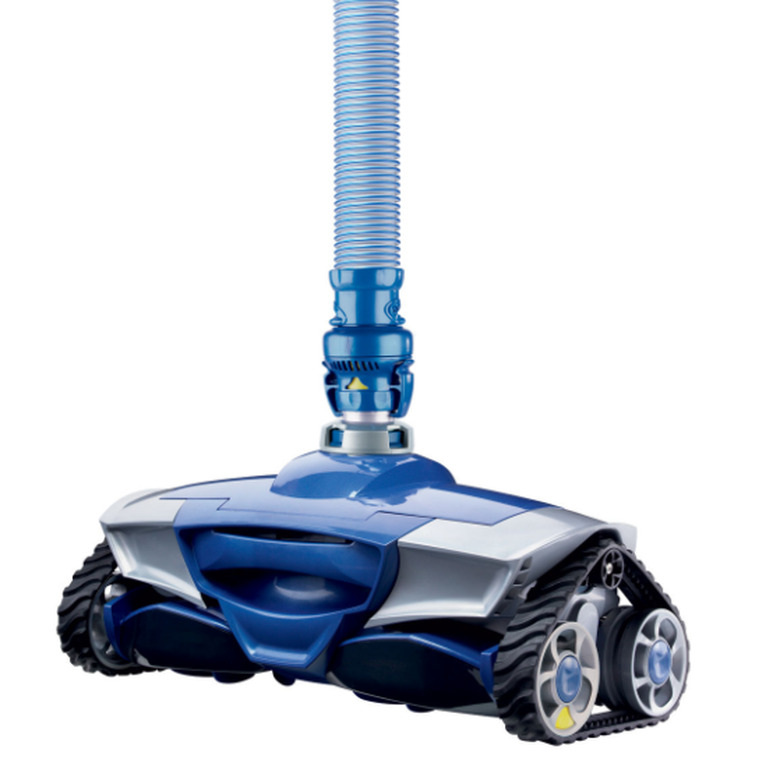How To Vacuum A Pool With A Cartridge Filter
Unless your pool is equipped with an automatic cleaning device, you're going to need to manually set up a vacuum to clean your pool regularly. The surface strainer on most pools will remove the largest floating debris, but the bottom of your pool collects grit and grim and small pieces of debris, and the only way to remove this is with a vacuum that runs along the bottom of the pool.
There are many types of these pool vacuum cleaners available, ranging from small rechargeable units equipped with simple filter baskets that strain out debris and silt as they are pushed along the bottom of the pool, to "robotic" units with dual-stage basket and cartridge filter systems that run automatically along the surfaces of your pool each time they are set up.
This latter type, usually known as a suction vacuum system, is by far more efficient at cleaning your pool. This type operates through a series of vacuum hoses that tap into your pool's filtration pump system, which actually provides the power to operate the vacuum unit. This has the advantage of allowing the vacuum to pump large quantities of water, thereby cleaning the surfaces of your pool much more rigorously and more quickly than cheaper handheld models. It also means no secondary source of power is needed, so there are no batteries or power cords necessary.
Better suction vacuum systems will use a cartridge filter insert that traps small particles of silt and grime, either in place of, or in addition to, a mesh debris basket built into the vacuum unit. When vacuuming is done, the basket and filter can be easily removed and rinsed out to prepare the vacuum for the next use.
While less expensive hand-operated suction systems are available, increasing numbers of pool owners are now opting for robotic systems that operate in much the same fashion as robotic floor vacuums for the home.
The following description of how to use a suction vacuum pool cleaner is based on the instructions for the Zodiac MX-8 cleaner, a very popular and well-regarded unit that operates automatically on the bottom of your pool each time you set it up. Most units from other manufacturers use a very similar method, and it should be an easy matter to adapt the following instructions to other types of suction vacuum pool cleaners.
Step 1
Make sure the water level in your pool is high enough to reach mid-level on the faceplate of your pool's skimmer. If the water level is too low, it will affect the vacuum's suction ability. Also, clean out any debris from the pool's basket strainer. The basket should be clean before starting your vacuum-cleaning routine.
Step 2
Position the vacuum unit on the edge of the pool farthest from the pool's filter unit, and join hose segments together to reach from the vacuum unit to the skimmer basket. Your goal is to make sure there is enough hose for the vacuum to reach all areas of the pool surface.
Step 3
Submerge the vacuum unit into the water and push the hose down into the water. This will empty all air from the hose. If there are air bubbles in the hose, the vacuum will not work effectively.
Step 4
Attach whatever adapter fitting is specified by the manufacturer onto the suction port on your pool's skimmer system. For some pools, this will be a port near the middle of the pool, found just below the surface of the water. It is possible that some type of permanent adapter fitting may need to be installed on the port in order to make the vacuum hose connection.
On other pools, this suction port will be found inside the skimmer canister on the deck of the pool. In this configuration, an elbow fitting is attached to the suction port inside the skimmer, then the vacuum hose is fed through the flapper door on the side of the pool and attached to the elbow fitting.
Step 5
Turn the pool filtration system on, then pull the vacuum unit to the side of the pool, and check the rotation speed of the wheels on bottom of the vacuum unit. Your pool's pump system can be adjusted to create the optimal wheel rotation for the vacuum unit, as specified by the manufacturer. The greater the water flow in your pool's system, the faster the wheel rotation on the vacuum unit will be. Too fast, and the vacuum will not clean effectively; too slow, and there is a risk of damage. Once the wheel rotation is optimal, return the vacuum unit to the bottom of the pool, and allow it to do its job for the recommended time, based on the size of your pool.
Step 6
Once cleaning is complete, pull the vacuum from the pool, disassemble all hoses, then clean the vacuum's strainer and filters with clear water before storing the unit.
Tip
Keep an eye on the pool pump's basket when vacuuming the pool. If you see that the basket runs dry, immediately turn off the pool system, open the pump basket lid to allow water to flow into the pump basket and then turn the pool's pump system back on. Check the skimmer to make sure that dirt and debris isn't preventing the water from getting to the pump basket.
